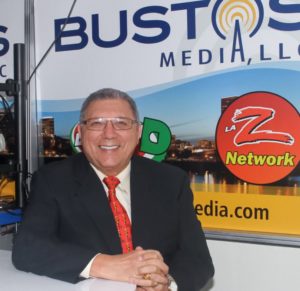
(By Amador Bustos) While it is common for many Hispanics in the radio business to dream of owning their own station or stations, historically they have found it to be a path under construction, with many roadblocks.
Spanish-language radio programs have been around for decades, but there were no stations broadcasting exclusively in Spanish before World War II. During radio’s formative years, English-language stations’ owners discovered they could boost their income by selling blocks of airtime on the weekends to independent businessmen called “brokers.”
Perhaps the most significant event in Spanish-language radio history occurred in 1947 in San Antonio, Texas. Radio broker Raul Cortez launched KCOR, the nation’s first full-time Spanish-language station owned and operated by a Hispanic. Cortez, however, was an exception. As Spanish radio grew in popularity, brokers commonly became station employees rather than owners.
By 1966, more than 300 radio stations were broadcasting in Spanish. Two-thirds of them were concentrated in the Southwest — California, Texas, Arizona, New Mexico, and Colorado.
More than 30 years later, the number of Spanish radio outlets had climbed to 461. In 2020 there are more than 1,000 Spanish-language radio stations in the U.S. But it is not all rosy. The vast majority of their ownership remains in the hands of publicly traded companies and/or Caucasian men.
The growth of Spanish-language broadcasting so alarmed some conservative commentators that on August 29, 2017, Fox News personality Tucker Carlson run a story titled “English language being displaced by Spanish.” He concluded his commentary by saying, “Spanish speakers are creating their own society, rather than assimilating into the country that welcomed them. It’s about unity for this country. If you are divided by language and culture, why are you a country?”
Progress on ownership has remained alarmingly slow, even after the Federal Communications Commission raised the issue and called for increasing diversity more than 40 years ago. It was 1977 when the FCC convened a historic Minority Ownership Conference in Washington, D.C. I attended, as a graduate student representing the Bay Area Bilingual Education League, and lobbied for more media diversity. That August the U.S. Commission on Civil Rights also released a report called “Window Dressing on the Set: Women and Minorities in Television.” It discussed the poor portrayal of women and minorities in television. It detailed the lack of minority anchors and news reporters as well as the abysmal numbers for people of color working in managerial and ownership positions.
The FCC conference led to a follow-up report a year later called “Minority Ownership of Broadcast Facilities.” It revealed some of the obstacles for potential minority broadcasters. The report stated, Hispanics, African Americans, Asian Americans, and Native Americans owned less than 1 percent of U.S. broadcast properties, even though they represented 20 percent of the population.
Fast forward to August 1998: A survey by the National Telecommunications and Information Administration (NTIA) found minority ownership inched up to 2.9 percent. Hispanic radio ownership was up to 1.2 percent (130 of the 10,315 commercial AM and FM radio stations).
But the trend would not continue. Minority ownership got worse with the advent of the Telecommunications Act of 1996, signed by President Bill Clinton on February 1996. The act was intended to bring more competition to the telephone market for local and long-distance services, but it also contained other provisions. One of them lifted the ownership restriction of two radio stations per market. That generated a buying frenzy and major consolidation, which gave birth to huge publicly traded companies like Clear Channel (now iHeartMedia).
Black and Hispanic broadcasters were losing ground fast with the new market forces. The commercial radio sector lost 17 Hispanic owners from 1997 to 1998. Minority broadcasters were finding it increasingly difficult to compete without access to big money. On the bright side, it provided a good exit for minority broadcasters who wanted to pay their debt and take some profits.
As a result, in 2020 minority ownership remains minimal. In the nation’s biggest radio markets, the few Spanish-language radio companies that survived the consolidation had to also grow big enough to become publicly traded.
Becoming publicly traded in turn blurs the distinction of minority-owned versus minority-managed. Most independent minority broadcasters, as is the case with Bustos Media Holdings, could play in that street and could only afford to buy less expensive stations in smaller markets.
Now in Congress, there is H.R. 3957, the “Expanding Broadcast Ownership Opportunities Act of 2019.” This proposed legislation is the most recent effort to aid minority ownership by reinstating the minority tax certificate. This policy is not new; it was around in the ’90s. It granted tax deferrals to owners who would sell to minorities. It was the most successful tool to foster minority ownership — until it was killed in 1995 by the Republican victory led by Newton Gingrich and his “Contract with America.”
Activist non-profit organizations like MMTC and trade organizations like NAB as well as governmental agencies have struggled for decades with adverse court rulings and political movements reversing minority incentives intended to remove the roadblocks on the path to a more equitable and representative broadcast industry.
Amador Bustos is the CEO of Bustos Media and can be reached by e-mail at [email protected]





